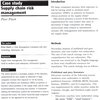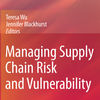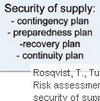 Does having Small and Medium-sized Enterprises (SMEs) in your supply chain constitute an increased exposure to supply chain risk? Particularly if these SMEs occupy business-critical positions in the supply chain? That’s the question Peter Finch asks in his 2004 article simply (or boldy?) titled Supply Chain Risk Management. I came across this article by mere accident, because it has not been much referenced in the supply chain risk literature. Perhaps, because Peter Finch is not an academic, but a management consultant, and because there is very little academic literature in his reference list, hence not worth mentioning? I don’t think so. This article can very well stand on its own and excellently explains the role that SMEs have in adressing risks in supply chains
Does having Small and Medium-sized Enterprises (SMEs) in your supply chain constitute an increased exposure to supply chain risk? Particularly if these SMEs occupy business-critical positions in the supply chain? That’s the question Peter Finch asks in his 2004 article simply (or boldy?) titled Supply Chain Risk Management. I came across this article by mere accident, because it has not been much referenced in the supply chain risk literature. Perhaps, because Peter Finch is not an academic, but a management consultant, and because there is very little academic literature in his reference list, hence not worth mentioning? I don’t think so. This article can very well stand on its own and excellently explains the role that SMEs have in adressing risks in supply chains
Grey literature case studies
One of the reasons why this article is perhaps not so widely cited is the use of grey literature. This was a new term to me.
Grey literature (or gray literature) is a term used variably by the intelligence community, librarians, and medical and research professionals to refer to a body of materials that cannot be found easily through conventional channels such as publishers, “but which is frequently original and usually recent”. Examples of grey literature include technical reports from government agencies or scientific research groups, working papers from research groups or committees, white papers, or preprints.
Fair enough, by my count, only 6 of the 40 or so references fall well into the academic realm.
Three levels of risk
What I do find interesting is the framework for risk analysis that Peter Finch uses. Bandyopadhyay et al. (1999) relates to risk analysis for IT systems in organizations, and not to risk in supply chains. However, since IT systems do have a business continuity mission, this framework is far from inapplicable:
- Application level
- technical failure, affecting local functions
- Organization level
- strategic failure, affecting all functions
- Inter-organizational level
- network failure, affecting suppliers and customers
Add to that, it does resemble the three-level structure seen in Jüttner et al. (2003), where risks can originate from within the organization, from within the supply chain, and from within the external environment.
Types of risk
Finch then exemplifies and discusses the typical risks that are associated with the three levels:
- Natural disasters
- flooding (apparently not so uncommon in the UK)
- Accidents
- poorly designed systems and procedures leading to human error
- Deliberate acts
- theft, sabotage, vandalism, terrorism
- Information security
- hacking, viruses, denial of service attacks
- Knowledge management
- skill acquisition and retainment
- Legal risks
- disclosure and intellectual property issues
- Strategic decision making
- actions of competitors
- Strategic alliances
- loss of control over key parts of supply chain
For each level/risk he also cites what is regarded as best practice vis-a-vis within the industry.
Do SMEs increase risk exposure?
According to Finch, yes and no. Many SMEs are not used to or trained in wide-ranging risk assessments to the same degree as large corporations are, and corporate supply chains my thus increase their exposure to risk by taking in SMEs, who in turn increase their own risk exposure to risks that are essentially outside of their control. However, all SMEs are capable of understanding and appreciating their own set of risks, and the risks they bring into the supply chain, as well as the overall corporate risks and the role they play in the wider perspective, if this is communicated clearly enough.
Conclusion
If you look at the list above, what I haven’t found much about in the supply chain risk literature so far is the importance of knowledge management, .i.e. hiring and keeping skilled personnel. That is a risk that is perhaps too often overlooked. The best thing about this article though is that there is very little, if any, academic discussions. It is all hands-on, example after example, and extremely operational; any corporate CEO all SME manager will be able to relate to the issues described, take the conclusions and put them into practice immediately.
Reference
Finch, P. (2004). Supply chain risk management Supply Chain Management: An International Journal, 9 (2), 183-196 DOI: 10.1108/13598540410527079
Author link
- Peter Finch
(whereabouts unknown)
Related
- husdal.com: Less supply chain risk with VMI?
- husdal.com: Trust, control and risk in strategic alliances
- husdal.com: How the wrong people can ruin a supply chain












